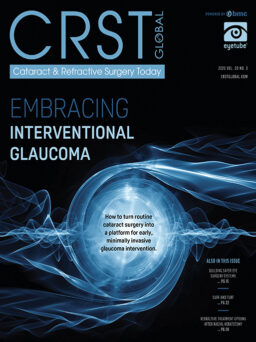GLAUCOMA
The Future is Now
By Kaweh Mansouri, MD, MPH

Dr. Mansouri offers the prediction that, by 2020, most tertiary glaucoma centers worldwide will offer 24-hour IOP monitoring. Two systems with capabilities in this realm are the Triggerfish (Sensimed), the world’s first smart contact lens, and the Eyemate sensor (Implandata), a silicone-encapsulated device intended for implantation during cataract surgery.
The Triggerfish lens measures a composite of IOP, volume, and elasticity of ocular tissue. Studies have shown that measurements taken by Triggerfish correlate strongly with tonometry, and it is conceivable that output from the lens may reflect changes that are more relevant to glaucomatous damage than pure IOP.
With the Eyemate, which has eight pressure-sensitive capacitors and a circular microcoil antenna, IOP measurements are performed with a reader unit held in front of the eye.
MIGS Update
By Joel Palko, MD; and Arsham Sheybani, MD


Curious about one or all of the procedures categorized under the term microinvasive glaucoma surgery (MIGS)? Then check out this article by Drs. Palko and Sheybani, in which they overview trabecular meshwork, canal-based, suprachoroidal, and subconjunctival MIGS procedures and devices. A comprehensive 1-page table comparing current MIGS options also accompanies the article.
http://bit.ly/palko1116
DRIVE EFFICIENCY
Top Five Technologies for a More Efficient Practice
By Lawrence Woodard, MD

In Dr. Woodard’s opinion, the considerable costs of adopting dropless cataract surgery, ORA with Verifeye+ (Alcon), the Motorized Optical Tilt Operation (Serj Instruments), Omidria formulation (phenylephrine and ketorolac injection; Omeros), and the Verion (Alcon) were worth the investments. With these technologies, he believes he has been able to deliver better outcomes and increase his practice’s efficiency, growth, and success.
http://bit.ly/woodard1116
Do You Need a Helping Hand?
An interview with Robert J. Weinstock, MD

An optometrist, the most common example of a physician extender, can take much of the burden off the surgeon in terms of seeing pseudophakic patients and those with healthy eyes who need only routine yearly exams, says Dr. Weinstock, adding that the surgeon is then free to see more surgical consults and handle more acute care situations. But can this translate into increased revenue? According to Dr. Weinstock, it can—in the range of US$150,000 to more than US$300,000 a year, depending on how busy the surgeon is.






